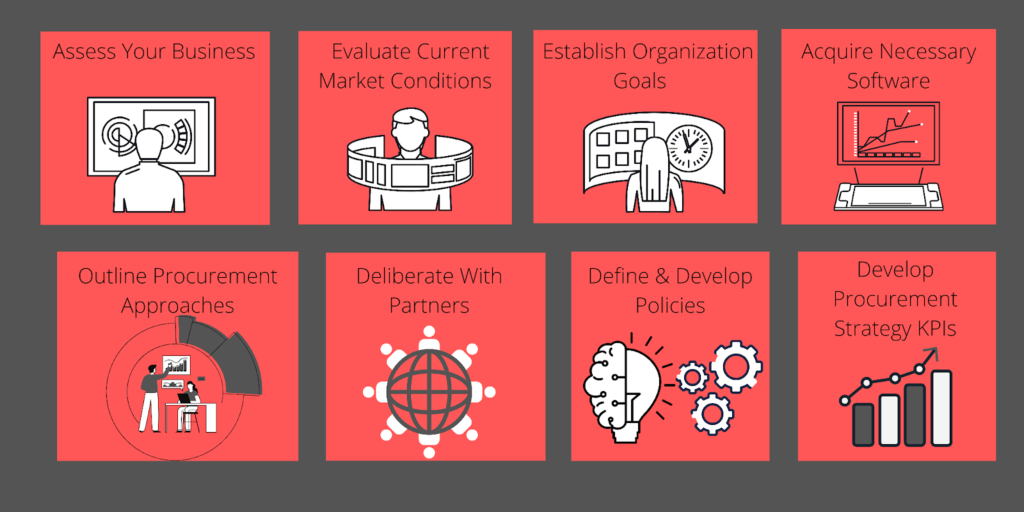Estimated reading time: 6 minutes
• What is procurement strategy?
• Procurement is a hinge operation in most organizations. Done right, it greatly facilitates cost mitigation, improves risk and supply chain management, and expedites sourcing.
• In order to tap into all the benefits of procurement, however, it’s imperative to have a good procurement strategy.
• But what is procurement strategy and how can you develop your own? Let’s explore.
What is Procurement Strategy?
Explained simply, a procurement strategy is a detailed plan of action, that’s been carefully thought out and has been developed by a procurement team for a particular organization or business. It highlights the best practices to follow when purchasing raw materials for production.
It’s a dedicated way of approaching sourcing and procurement of goods and services.
Procurement strategies, while typically long-term in nature, can also be short-term based on the unique, individual needs of the organization.
And in case you’re wondering about the importance and difference a procurement strategy can make, here’s a look at the benefits of having one.
Benefits of a Procurement Strategy

· Coherent and Unified Approach
· Cost-Effective Sourcing
· Expeditious Sourcing
· Minimized Supply Chain Risk
· Improved Vendor Management
1. Coherent and Unified Approach
A procurement strategy ensures that all procurement team members are on the same page regarding company sourcing and procurement tactics.
The strategy establishes the protocol to be followed when dealing with vendors and describes the practices that allow the company to achieve its procurement objectives.
2. Cost-Effective Sourcing
The U.S. annual inflation rate shot up to 7.9% in February 2022. This is the highest it’s ever been since January 1982. This is problematic as it causes prices all along the supply chain to also rise – leading to higher production costs that have to be passed on to consumers.
How does having a procurement strategy ensure cost-effective sourcing? With well-established vendor relationships, you’re able to negotiate better prices and may even secure discounts that allow you to keep consumer prices stable.
3. Expeditious Sourcing
Given that 43% of businesses do not track their inventory and only 22% of organizations actually have a proactive supply chain network, a lot of companies are extremely vulnerable when it comes to sourcing.
However, this can all change with a fully-functional procurement strategy. The strategy ensures that inventory is monitored and tracked and that critical components are ordered in a timely manner to avoid disruptions that may halt production.
4. Minimized Supply Chain Risk
According to Zippia.com, just 6% of U.S. businesses claim to have full visibility of their entire supply chain. To compound matters, their research also showed that supply chain disruptions can result in a 62% loss in finances.
With so much at stake, companies cannot afford to be lax about how they approach procurement. You’ve got to have a strong procurement policy in place. It’s non-negotiable if you want to remain competitive.
5. Improved Vendor Management
Good vendor management is pivotal to successful procurement operations. Having established policy and procedures on how to address supplier relationships is the first step to effective vendor management.
Now that we know what procurement strategy is and its importance, let’s find out how to develop a strategy for your company.
8. Steps to Formulating a Procurement Strategy
It’s worth noting that there is no one-size-fits-all model when it comes to procurement strategy. What’s key is knowing what your business procurement goals are and aligning your planning accordingly.
You can create your procurement strategy around any of these targets:
· Cost Reduction
· Global Sourcing
· Green Purchasing
· Quality Management
· Risk and Supply Chain Management
Having chosen a target, here are eight steps you can follow to craft a unique procurement strategy.

1. Assess your business
2. Evaluate current market conditions
3. Establish organizational goals
4. Outline procurement approaches
5. Deliberate with partners
6. Acquire necessary software
7. Define and develop policies
8. Develop procurement strategy KPIs
1. Assess Your Business
Visibility into current and existing procurement operations is critical before attempting to introduce new systems and ways of doing things. Evaluate where the business is, its needs, and what will be required in the future. With this picture in mind, formulating a procurement strategy that matches the current and future needs is easier.
2. Evaluate Current Market Conditions
What’s happening in the market in this post-COVID era? What are vendors saying? You can’t make moves without knowing how the markets have shifted and changed. This step is key as it can highlight new opportunities that you may wish to pursue.
3. Establish Organizational Goals
With business evaluation and market analysis done, it’s time to outline the organization’s existing procurement functions. This process will be laborious as it will delineate aspects such as what products, raw materials, and services are needed, quantities, and by when.
4. Outline Procurement Approaches
This is undoubtedly the most important part as it involves setting down the procedures, protocols, and procurement approaches you’re going to implement. It necessitates reviewing old practices and either tweaking these or completely overhauling them and introducing new tactics.
5. Deliberate With Partners
In order to develop a pragmatic procurement strategy, it will require input from your partners as well. Listening to your vendors allows you to shape your processes and conform to good industry practices. This ensures the strategy will be streamlined, practical, and efficient.
6. Acquire Necessary Software
Procurement operations rely heavily on suitable procurement software. Power your operations with supplier management software, RFx solutions, and automated invoices from vendors like ProcurePort. This saves your team time typically spent on administrative tasks.
7. Define And Develop Policies
With all the information you’ve gathered, it’s time to carefully draft your procurement strategy. Think through issues like compliance, quality, delivery, time, and vendors, as you create the policy upon which your sourcing and procurement will rest.
8. Develop Procurement Strategy KPIs
The final step involves developing key performance indicators (KPIs) that will help you measure and assess the success of your new procurement strategy. This is paramount as you’ll want to quickly change procedures that aren’t working or reinforce those that are.
Wrap Up
The success of your procurement strategy is intertwined with the software you’re using. To see what’s on the market, we’ve detailed how procurement software has progressed in 2020 already.
From supplier management software to RFx options, ProcurePort provides you with reliable, robust, and innovative solutions that are trusted and used by businesses and organizations such as UNOPS, HUD.GOV, and conEdison.
To discuss procurement software with a consultant or to schedule a demo of our solutions, contact us today.










